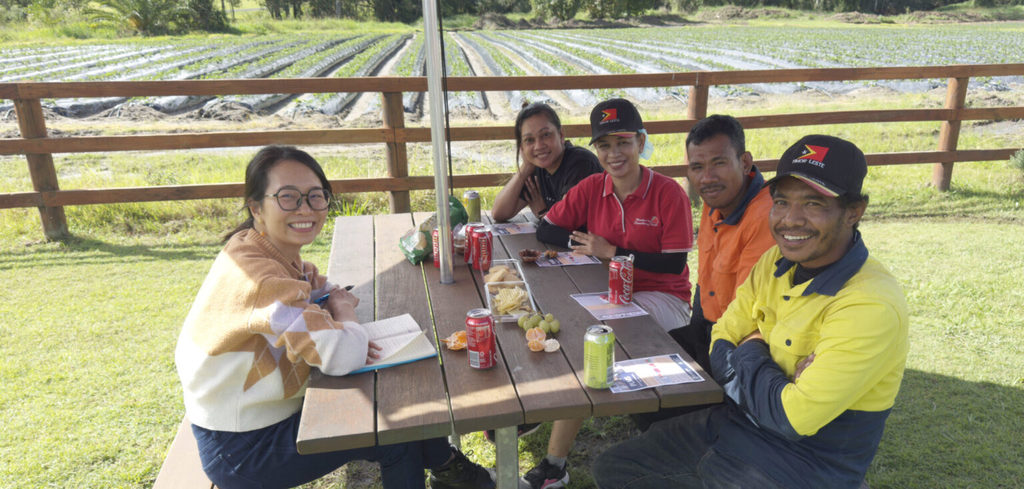The Seasonal Worker Program (SWP), now under the Pacific Australia Labour Mobility (PALM) scheme as its “short-term” stream, was launched in 2012 with two objectives: “to contribute to economic development in partner Pacific countries” and “to provide benefits to Australian employers and the domestic economy”.
There is ample evidence to assess the SWP against its first objective, including a 2018 World Bank report, our 2023 joint report based on Wave One of the Pacific Labour Mobility Survey (PLMS) and an abundance of descriptive qualitative work.
Evidence on the second objective is in shorter supply. Prominent grey literature (for example, reports on labour supply in horticulture and productivity) has been discussed extensively on this article (available via hyperlink on devpolicy.org) . More recently, Jobs and Skills Australia conducted a Food Supply Chain Capacity Study and Richard Curtain provided an updated assessment of some of the challenges facing the PALM scheme.
Despite its dual objectives and growing importance, it is striking that there remains no rigorous causal evidence on whether the SWP — or the PALM scheme today — has had any effect on key domestic indicators of interest. The situation for New Zealand’s Recognised Seasonal Employer (RSE) scheme is similar (with only discontinued RSE employer surveys, the RSE Impact Study and some ongoing work similar to what we discuss here).
In a new Development Policy Centre discussion paper, we ask a straightforward but first-order question: did the SWP reduce the earnings of domestic workers in similar jobs? Measuring the impact of the SWP on domestic outcomes presents at least three challenges. One, data are not readily available.
Two, the program started small and grew slowly until the pandemic, meaning there might not have been enough of a “treatment” for any effects to be statistically discernible. Three, employers self-select at the application stage, are then approved by the government, decide how many SWP workers to use, then decide whether to use those workers, making selection bias potentially severe.
Our analysis is based on Australian tax and visa records, accessed and analysed through the Australian Bureau of Statistics (ABS) DataLab cloud environment. As far as we are aware, our paper is the first to use this exciting new administrative data to estimate the impacts of immigration and the first in the world to measure the wage impacts of seasonal work visas. To construct a reliable measure of domestic worker exposure to the SWP, we use visa records to pinpoint the location and occupation of every SWP worker.
We then link the visa data to individual tax returns and classify every domestic worker in the same localities and occupations, whose earnings we observe precisely every year. The figure below plots the earnings of labourers in treatment and control regions before and after the announcement of the SWP.
Treatment regions are those where the SWP accounted for more than 7 per cent of the local labourer workforce at its peak. Control regions are those where it was less than 1 per cent and we exclude greater capital regions from both. Notice how these two lines tracked each other closely before the SWP was introduced. This gives us some early confidence that any major changes in the years that follow might be reasonably attributed to the program.
For the second challenge, we take a long view and focus on (a) cumulative impacts from the SWP’s 2012 announcement until its pre-pandemic peak in 2018, (b) workers in the same jobs, most directly exposed and (c) regions with the highest SWP intensity, accounting for more than 7 per cent of the labourer workforce.
To isolate the causal effect of the SWP, we zoom in on what we believe to be the most demanding and credible counterfactual comparisons available in this context: a “triple difference” approach comparing the earnings trajectories, from 2011-18, of labourers working in SWP locations against similar workers within the same localities, which are then compared to those in regions not exposed to the SWP.
As we observe every taxpayer in every year, we are able to include “individual fixed effects” in our estimation, accounting for any person-level unobservable heterogeneity. We also measure impacts at the regional level and across occupations (at the national level) using less demanding “double difference” designs, which tend to be more common in the literature.
Our main result is that the introduction and expansion of the SWP does not appear to have any statistically discernible impact on the earnings of local farm workers in the most affected occupations and regions. This overall null finding of no adverse impacts for incumbent labourers is robust across a range of approaches.
The key question is then how labour markets absorb SWP workers. We explore two possibilities. First, we examine employment in the most exposed regions, as wages would be unlikely to change if SWP workers displace natives. We find no evidence of dis-employment (see Section 5.1 of the paper). An alternative explanation brings us back to what motivates seasonal visa programs: filling narrow labour market gaps, where native labour supply is perceived to be low. Is this the case in Australia? We think so.
Before the SWP was established, population growth was systematically slower in more agricultural areas. National figures tell a similar story, with the number of farm workers declining by 8.4 per cent from 2006-11 while the number of other labourers remained relatively constant and workers in all other occupations grew by 11.7 per cent.
Clearly, agricultural roles were becoming increasingly difficult to fill even as the broader labour market was expanding. Rather than substituting existing farm workers, the SWP supplemented a shrinking workforce where domestic supply was failing to meet employer demand. This interpretation is also consistent with earlier work by one of us (Toan Nguyen) showing how Australia’s demand-driven visas tend to do exactly this.
While our findings naturally do not generalise to other types of immigration, they are consistent with the two best empirical studies on labour market impacts of immigration in Australia (see story at devpolicy.org for these reports) and thus not surprising.
Nonetheless, empirical exercises like this are helpful for forming evidence-based opinions on important policy issues where evidence is thin, as well as disciplining our models of how immigration and the PALM scheme affects the economy more broadly.
Disclosure: This research was supported by the Pacific Research Program, with funding from the Department of Foreign Affairs and Trade. The views are those of the authors only.
This article appeared first on Devpolicy Blog (devpolicy.org), from the Development Policy Centre at The Australian National University.
3304111

editor@fijitimes.com.fj



